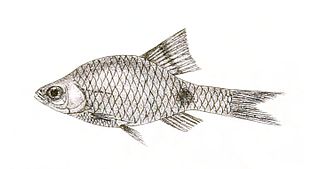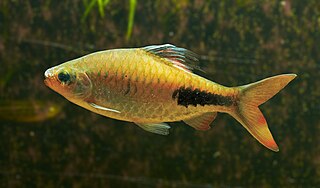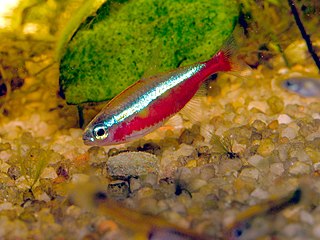
The Western Ghats, also known as the Sahyadris, is a mountain range that stretches 1,600 km (990 mi) along the western coast of the Indian peninsula. Covering an area of 160,000 km2 (62,000 sq mi), it traverses the states of Gujarat, Maharashtra, Goa, Karnataka, Kerala and Tamil Nadu. The mountains form an almost continuous chain of mountains along the western edge of the Deccan Plateau from the Tapti river to the southern tip of the Indian peninsula at Kanniyakumari. The Western Ghats meets with the Eastern Ghats at Nilgiris before continuing south.

The rosy barb is a subtropical freshwater cyprinid fish found in southern Asia from Afghanistan to Bangladesh.

Puntius is a genus of small freshwater fish in the family Cyprinidae native to South Asia and Mainland Southeast Asia, as well as Taiwan.

The ticto barb or twospot barb is a species of subtropical freshwater fish belonging to the family Cyprinidae. It is a native of the upper Mekong, Salwen, Irrawaddy, Meklong and upper Charo Phraya basins in the countries of Nepal, India, Pakistan, Myanmar, Bangladesh, Thailand, and Sri Lanka. It has frequently been confused with the Odessa barb in the aquarium trade, but in that species the male is reddish-orange.

Chalakudy River or Chalakudy Puzha is the fifth longest river in Kerala, India. The river flows through Thrissur district, Palakkad district and Ernakulam district of Kerala. The total drainage area of the river is 1704 km2. Out of this,1404 km2 lies in Kerala and the rest in Tamil Nadu. The length of the river is 145.5 km. Though Chalakudy River in strict geological sense is a tributary of the Periyar river, for all practical purposes it is treated as a separate river by Government and other agencies. The river has gained its name since it flows along the banks of the Chalakudy Town, the major settlement along the course of the river. It is perhaps the most unpolluted and pristine river in the state and even in India due to the limited amount of industries and wastage disposal around it. Chalakudy River and its basin area were one of the most affected rivers during the 2018 Kerala floods.

The swamp barb, also known as chola barb, is a species of tropical freshwater fish belonging to the subfamily Cyprininae of the family Cyprinidae. It originates in inland waters in Asia, and is found in Pakistan, India, Nepal, Bangladesh, Sri Lanka, Bhutan, and Myanmar.

The onespot barb or Teri barb is a tropical freshwater fish belonging to the Cyprininae sub-family of the family Cyprinidae. It originates in inland waters in Asia, and is found in Pakistan, India, Bangladesh, Myanmar. It was originally described as Cyprinus terio by Dr. Francis Buchanan-Hamilton in 1822, and has also been referred to in scientific literature as Systomus terio or Barbus terio.

The greenstripe barb, silver barb or striped barb is a tropical freshwater and brackish fish belonging to the subfamily Cyprininae of the family Cyprinidae. It originates in inland waters in Asia, and is found in Pakistan, India, and Sri Lanka.

The dwarf pufferfish, also known as the Malabar pufferfish, pygmy pufferfish, or pea pufferfish, is a small freshwater pufferfish endemic to Kerala and southern Karnataka in Southwest India. They are popular in aquaria for their bright colours and small size. At a maximum total length of 3.5 cm, dwarf pufferfish are one of the smallest pufferfish in the world. They closely resemble the related Carinotetraodon imitator, and the two can be difficult to distinguish. C. imitator was not recognised as a different species until 1999.

Dawkinsia assimilis is a species of ray-finned fish in the genus Dawkinsia. It is endemic to the southern Western Ghats especially to the Southwest Indian states of Karnataka and Kerala. They are known as Mascara Barb. Filament barbs are a group of small freshwater fishes found in the rivers of peninsular India and Sri Lanka. There are nine species known under the genus Dawkinsia. These barbs are popular among aquarium hobbyists as an ornamental fish and are also collected from rivers and bred for trade.

The redside barb or two-spot barb is a species of ray-finned fish in the genus Puntius. It is found in India and Sri Lanka. It was identified and classified by Pieter Bleeker in 1863.
Sahyadria chalakkudiensis is a species of cyprinid fish endemic to the Chalakkudy River, Kerala, India in the Western Ghats where it can be found in well-vegetated upper reaches of rivers. This species can reach a length of 12.5 centimetres (4.9 in) TL. It resembles the related S. denisonii, but the colours of S. chalakkudiensis are less intense.
Pethia setnai is a species of cyprinid fish native to streams of the Western Ghats, India. It is an endemic fish and is most commonly found in flowing sections of hill streams and smaller rivers. It can reach a length of up to 5.7 centimetres (2.2 in) TL. The species named after later Dr. Sam Bomansha Setna, who was the first Director of Fisheries of the erstwhile Bombay State.

Dawkinsia is a genus of cyprinid fishes from freshwater in South India and Sri Lanka. It was split off from genus Puntius in 2012.

Pethia is a genus of small freshwater fish in the family Cyprinidae native to South Asia, East Asia and Mainland Southeast Asia. Some species are commonly seen in the aquarium trade. The name Pethia is derived from the Sinhalese "pethia", a generic word used to describe any of several small species of cyprinid fishes. Most members of this genus were included in Puntius, until it was revised in 2012.

Sahyadria is a genus of cyprinid fishes native to India where they are endemic to rivers and streams in the Western Ghats. They were formerly included in Puntius. The largest Sahyadria measure 15 cm (5.9 in) total length.

Project Piaba is a fishery initiative located on the Rio Negro tributary of the Amazon River. The program both promotes and researches sustainable aquarium pet fish collection and its impact on the environment. The name of the project comes from the Brazilian Portuguese word, piaba, which means "little fish", referring specifically to the cardinal tetra. Project Piaba is an ongoing project with annual research expeditions to the Rio Negro region. Because of the sustainable nature of the project, its slogan is "Buy a Fish, Save a Tree!"

Prof. (Dr) B. Madhusoodana Kurup is an Indian fisheries researcher, academic and administrator. He is the Founder Vice-Chancellor of Kerala University of Fisheries and Ocean Studies (KUFOS), Cochin and also served as the third Vice Chancellor of Shri Venkateshwara University, Gajraula, Uttar Pradesh. He has established and successfully developed the first Fisheries and Ocean Sciences University in the country. He did his postdoc from Fish Culture and Fisheries division, Wageningen University & Research, The Netherlands. He served as UGC Professor (Fisheries) at Cochin University of Science and Technology (CUSAT) for over eighteen years.

Tor malabaricus, the Malabar mahseer, is a fish, a species of mahseer native to southwestern India.
Pseudeutropius mitchelli is an endangered species of freshwater fishes endemic to Kerala, India that belongs to the family of Schilbid catfishes. It is known as Malabar patashi.





















